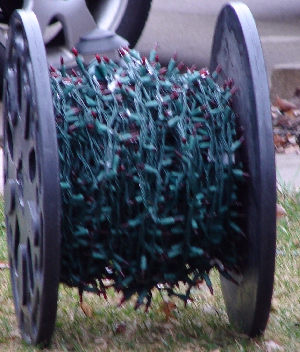 This is a great way to store mini lights. This is an empty roll from hydraulic hose. The roll is 22" in diameter and 20" wide. It can hold 30 strings of mini lights and still stay light enough to carry. They also stack nicely. I also use these spools to store my extension cords. I plug them in end to end to end in one continous string then wind them up. These are not as light as the lights so I use smaller spools so I can lift them easier.
This is a great way to store mini lights. This is an empty roll from hydraulic hose. The roll is 22" in diameter and 20" wide. It can hold 30 strings of mini lights and still stay light enough to carry. They also stack nicely. I also use these spools to store my extension cords. I plug them in end to end to end in one continous string then wind them up. These are not as light as the lights so I use smaller spools so I can lift them easier.
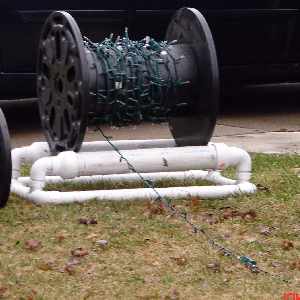 This roller is made from PVC.
The frame is made from (4)1 1/2 tees, (8) 1 1/2 Ells, (4) 2"X3" reducers, and 1 section of pipe.
The 2" part of the reducer fits over the outside of the ells loosly providing a bearing surface. This system works fairly well but when you are winding 30,000 lights your arms will get tired from spinning the roll. So I designed and built an automatic winder.
This roller is made from PVC.
The frame is made from (4)1 1/2 tees, (8) 1 1/2 Ells, (4) 2"X3" reducers, and 1 section of pipe.
The 2" part of the reducer fits over the outside of the ells loosly providing a bearing surface. This system works fairly well but when you are winding 30,000 lights your arms will get tired from spinning the roll. So I designed and built an automatic winder.
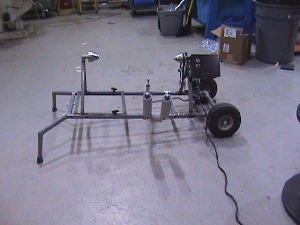 This is a contraption that I made for winding the strings of lights. It uses a 25 RPM gearmotor to spin the spool which is mounted on live center cones that I had made.
This is a contraption that I made for winding the strings of lights. It uses a 25 RPM gearmotor to spin the spool which is mounted on live center cones that I had made.
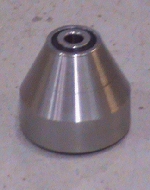 These allow the spool to spin freely to unwind the strings of lights. The one end is just simply a bearing to support the one side of the spool, this side also slides back and forth to allow different width spools to be used. The cone is made from steel and has a 1.375" hole in the middle to hold the flanged bearing. This bearing has a 1/2" hole.
These allow the spool to spin freely to unwind the strings of lights. The one end is just simply a bearing to support the one side of the spool, this side also slides back and forth to allow different width spools to be used. The cone is made from steel and has a 1.375" hole in the middle to hold the flanged bearing. This bearing has a 1/2" hole.
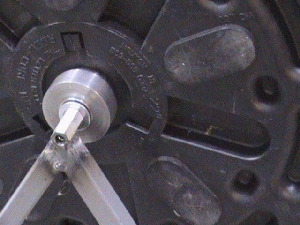 This cone engages the spool like this. It simply supports the weight on a nice set of bearings to remove the friction. The cone is supported by 1" square tubing bracket with a 1/2-13 bolt threaded into a coupling nut welded to the top.
This cone engages the spool like this. It simply supports the weight on a nice set of bearings to remove the friction. The cone is supported by 1" square tubing bracket with a 1/2-13 bolt threaded into a coupling nut welded to the top.
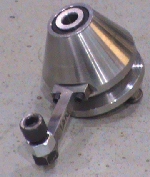 The other side is the driven side which uses a belt to transfer power from the pulley mounted to the motor to the driven cone. This cone has an arm which engages the spool to make it rotate. The pulley is the same diameter as the cone so the cone also rotates at 25 RPM. This seems like the appropriate speed to keep the lights intact but fast enough to keep the cycle time down.
The other side is the driven side which uses a belt to transfer power from the pulley mounted to the motor to the driven cone. This cone has an arm which engages the spool to make it rotate. The pulley is the same diameter as the cone so the cone also rotates at 25 RPM. This seems like the appropriate speed to keep the lights intact but fast enough to keep the cycle time down.
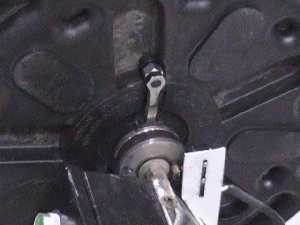 This picture shows how the cone engages the spool. Instead of relying on just friction this arm engages one of the slots located in the spool to drive it.
This picture shows how the cone engages the spool. Instead of relying on just friction this arm engages one of the slots located in the spool to drive it.
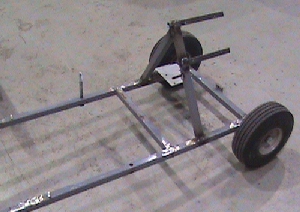 This whole mechanism is mounted to a two wheel dolly to make it very portable and storable. Besides the winding mechanism is an indexing mechanism which moves a little with each rotation of the spool. This is done with a geramotor which is connected to the guide arm with a creank arm and connecting rod.
This whole mechanism is mounted to a two wheel dolly to make it very portable and storable. Besides the winding mechanism is an indexing mechanism which moves a little with each rotation of the spool. This is done with a geramotor which is connected to the guide arm with a creank arm and connecting rod.
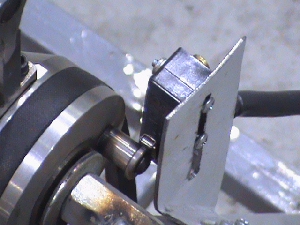 The indexing mechanism uses the same model gearmotor to move. It is supplied power through a microswitch that is tripped with a dog that is mounted to backside of the driven cone.
The indexing mechanism uses the same model gearmotor to move. It is supplied power through a microswitch that is tripped with a dog that is mounted to backside of the driven cone.
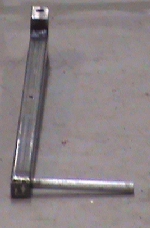 The arm is made from 1"X1/16" square tubing. The pivot end is made from a solid piece of 1"X1 1/2"X3" block of steel. It was machined to allow the 1" tubing to slide into the side of it then welded in place. The pivot is simply a 1/2" bolt welded square to the frame. This pivot block has a 1/2" hole in it which slides nicely over the bolt. The 1" tubing was cut long enough for the end guide to miss contacting the spool while it is spinning. The 1/2" rod sticking out the side of the arm is the axle for the horizontal guide roller.
The arm is made from 1"X1/16" square tubing. The pivot end is made from a solid piece of 1"X1 1/2"X3" block of steel. It was machined to allow the 1" tubing to slide into the side of it then welded in place. The pivot is simply a 1/2" bolt welded square to the frame. This pivot block has a 1/2" hole in it which slides nicely over the bolt. The 1" tubing was cut long enough for the end guide to miss contacting the spool while it is spinning. The 1/2" rod sticking out the side of the arm is the axle for the horizontal guide roller.
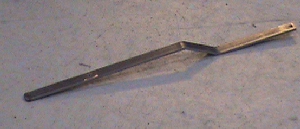 Connecting the guide arm and the crank arm on the motor is a connecting bar made from 3/4"X3/16" flat stock. I cut it extra long to allow for fitting. I drilled and mounted it with a 1/4" bolt on the motor side. This bolt was made long enough to allow for a pivoting motion. Then to fing the correct length I used a small C clamp to hold the connecting bar to the guide arm. then I tried it by powering up the motor. I moved the clamping point a couple of times untill I got the right start and stop points for the sweeping action.
Connecting the guide arm and the crank arm on the motor is a connecting bar made from 3/4"X3/16" flat stock. I cut it extra long to allow for fitting. I drilled and mounted it with a 1/4" bolt on the motor side. This bolt was made long enough to allow for a pivoting motion. Then to fing the correct length I used a small C clamp to hold the connecting bar to the guide arm. then I tried it by powering up the motor. I moved the clamping point a couple of times untill I got the right start and stop points for the sweeping action.
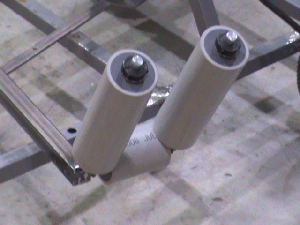 The guide on the end of the mechanism is made from 2" PVC pipe and PVC solid roundstock which fits inside the 2" PVC. A 1/2" hole was drilled into the solid PVC in the center. This solid bar was now a tube 1/2" I.D. and 2 1/8 O.D. Then it was sliced into 1/2" slices and glued into the PVC tubing at the ends to make rollers. Then 1/2" split shaft collars with 1/2" steel round bars wleded to them were used as the stops for the horizontal roller and axles for the verticle rollers. These rollers were set so that there was only about .010" between the bottom of the vertical rollers and the horizontal ones.This keeps te strings of lights from getting caught in between the rollers.
The guide on the end of the mechanism is made from 2" PVC pipe and PVC solid roundstock which fits inside the 2" PVC. A 1/2" hole was drilled into the solid PVC in the center. This solid bar was now a tube 1/2" I.D. and 2 1/8 O.D. Then it was sliced into 1/2" slices and glued into the PVC tubing at the ends to make rollers. Then 1/2" split shaft collars with 1/2" steel round bars wleded to them were used as the stops for the horizontal roller and axles for the verticle rollers. These rollers were set so that there was only about .010" between the bottom of the vertical rollers and the horizontal ones.This keeps te strings of lights from getting caught in between the rollers.
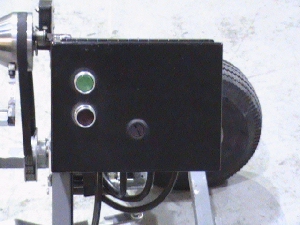 The whole thing is controlled with a simple start stop circuit with a relay. push green to start and red to stop. Soon to be upgraded to a remote control, like a garage door opener.
The whole thing is controlled with a simple start stop circuit with a relay. push green to start and red to stop. Soon to be upgraded to a remote control, like a garage door opener.
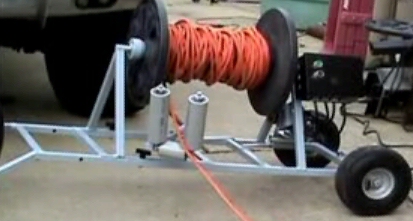 This little machine really saves me time when rolling up 400+ strings of lights. Woth my previous PVC roller set up my hands used to really hurt by the time I was done rolling them all up. Select the picture to the left to see video of it in action.
Hi res version.
This little machine really saves me time when rolling up 400+ strings of lights. Woth my previous PVC roller set up my hands used to really hurt by the time I was done rolling them all up. Select the picture to the left to see video of it in action.
Hi res version.
The spools of extension cord weigh in at about 70lbs when full. It works very nice and can pull about 150' of cord with no problem.
 This is a great way to store mini lights. This is an empty roll from hydraulic hose. The roll is 22" in diameter and 20" wide. It can hold 30 strings of mini lights and still stay light enough to carry. They also stack nicely. I also use these spools to store my extension cords. I plug them in end to end to end in one continous string then wind them up. These are not as light as the lights so I use smaller spools so I can lift them easier.
This is a great way to store mini lights. This is an empty roll from hydraulic hose. The roll is 22" in diameter and 20" wide. It can hold 30 strings of mini lights and still stay light enough to carry. They also stack nicely. I also use these spools to store my extension cords. I plug them in end to end to end in one continous string then wind them up. These are not as light as the lights so I use smaller spools so I can lift them easier. 












